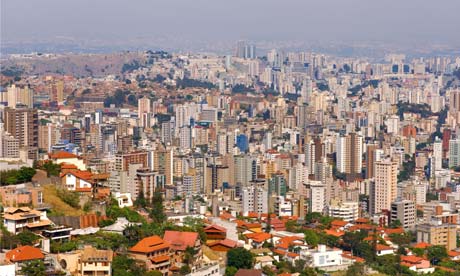drug mules
 Brazil ecstasy haul points to new generation of drug mules.
Brazil ecstasy haul points to new generation of drug mules.
Demand for synthetic drugs has led to the rise of ‘narco-turistas’, many of whom are affluent and university-educated.
Belo Horizonte in Minas Gerais state has become a key entry point for the ‘narco-turistas’. Photograph: Hemis
Early one October morning, João Geraldo de Almeida climbed out of bed and set off for the barbecue of his life.
Escorted by a convoy of armed police, he climbed into the mountains outside Brazil’s third largest city, strapped on a face mask and set fire to nearly six tons of illegal drugs. “It was the biggest quantity of drugs we’d ever burned,” boasted Almeida, head of the Federal Police drug squad in the Brazilian state of Minas Gerais.
The annual incineration of police hauls of marijuana and cocaine is nothing new to South America, home to some of the biggest coca fields and marijuana plantations on Earth. But among Almeida’s haul was a more unusual find: about 70,000 ecstasy pills and 16,000 tabs of LSD.
The drugs pointed to a growing phenomenon: the use of so-called “synthetic” drugs such as ecstasy, MDMA powder and GHB in South America’s largest nation.
Brazil remains one of the largest cocaine consumers in the world and a major transit point for the drug. But a recent report by the UN’s Office on Drugs and Crime suggested consumption of synthetic drugs, stable or falling in much of Europe, is on the rise in Brazil and other South American countries.
The demand for such drugs has spawned a new generation of drug mules. In Brazil they call them “narco-turistas”.
“They are passengers who leave the country, spend 10 days sightseeing in Europe and then come back with the drugs. They fake a holiday,” said Almeida in Belo Horizonte, capital of Minas Gerais. “If you look at their cameras they’ll have a whole load of photographs of tourist spots, sometimes even from several different countries.”
Brazil’s narco-turistas bear little resemblance to South America’s traditional drug mules – desperate, cash-strapped locals, Africans or Europeans, who smuggle stomachs or suitcases of cocaine from airport to airport for a fraction of their cargo’s worth.
Instead, security officials say narco-turistas are well-off, university-educated Brazilians. “They are much harder to locate because they blend in with your average passenger,” said Almeida. “They’re not like your traditional drug mules whom you can spot in the airport queue. They are middle class and upwards. They are never poor.”
Foreign mules are regularly caught trying to ferry South American cocaine back to Europe – this year Romanian, Spanish and Polish citizens have been arrested at Belo Horizonte’s Confins airport. But the narco-turistas are exclusively Brazilian. Normally they have no criminal record. They are often students, nearly always men, nearly always wealthy.
“In our investigations we have come across a lot of high-level people,” said Almeida, his desk stacked with sky-blue investigation files. “We’ve arrested lawyers, doctors, business people, the owner of one gym. These are people who go to Europe a lot. They are students, they might have studied in Europe, or been on tourism trips there, or business trips.”
Thanks to its booming economy – mineral-rich Minas Gerais is Brazil’s third richest state – and improved flight connections to Europe, Belo Horizonte has become a key entry point for such traffickers. Of about 194,000 ecstasy pills seized by police in Brazil so far this year, 92,000 were seized in Minas Gerais, Almeida said. Nearly all were found at the city’s Confins airport, from which there are direct flights to Lisbon. From Portugal, narco-turistas fly to other European countries to pick up the drugs, with Belgium and Holland two of the key pick-up points.
“100% of the drugs we are seeing here are coming from overseas. None of them are produced here [in Brazil]. None of our investigations have led us to believe that there might be an [ecstasy laboratory] here in Belo Horizonte,” said Almeida.
A report released in September by the EU’s border management agency, Frontex, claimed the narco-turistas believed they were less likely to be caught at airports such as Confins.
“The target airports are not the ones in Rio de Janeiro and São Paulo, the main international hubs in the country. Rather, because of the belief that the larger airports are more closely and thoroughly watched, traffickers prefer to use secondary hubs such as the airports in Belo Horizonte, Salvador and Recife, where direct flights to Portugal, Spain, France and Germany are available.”
The growing role of the narco-turistas has underlined how Brazil’s drug scene is no longer just about rolled-up banknotes and furtive trips to the bathroom.
In 2001 Brazil’s federal police reported seizing 1,909 ecstasy pills at the country’s borders and airports. Ten years on, that figure has mutiplied by 100.
After a July operation that dismantled an ecstasy trafficking ring which had been importing 30,000 pills each month from Holland, drug squad chief João Luiz Caetano de Araújo said: “Synthetic drugs are slowly replacing cocaine consumption.”
“It is a cleaner drug, it is easier to sell and it is consumed more by the middle class,” he told the Brazilian news magazine Veja.
Next year the changing habits of Brazilian drug users will make their big screen debut, with the release of Artificial Paradises, a feature film focusing on “Brazil’s ecstasy generation”.
Click Here for guardian.co.uk/world/2011/dec/18/brazil-ecstasy-synthetic-drug-mules
